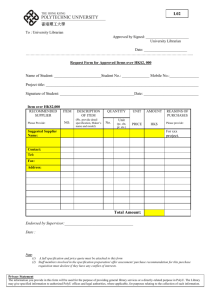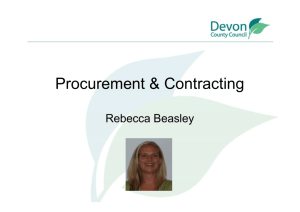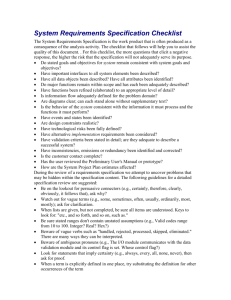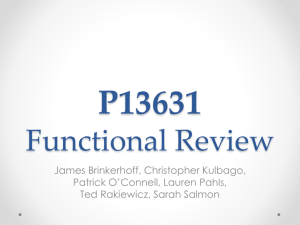Specification Writing
advertisement
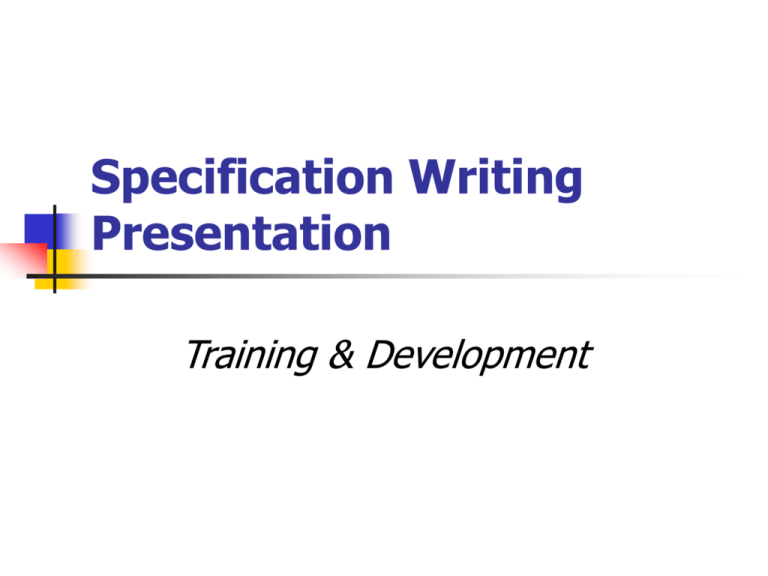
Specification Writing Presentation Training & Development This presentation has been designed to assist in the preparation of Specifications for the purchase of goods/services. Use this presentation to guide you through the Accredited Purchasing Unit’s Guidelines for Writing Specifications document. Overview Definition Before preparing a Specification Importance of Clear Specifications Writing the Specification Specification Content The Structure of a Specification Vetting and Obtaining Approvals Simple Vs Complex Specifications Staged Purchasing DECS Procurement Policies & Guidelines What is a Specification? A statement of needs, defining what the purchaser wants to buy and what the supplier is required to provide. Specifications are used to: Ensure chosen supplier provides what is specified and; Measure the performance of the supplier throughout the contract. Specifications are based on information provided in the Acquisition Plan – will form part of a tender document or a request for quote. Before preparing a Specification Identify customer/user needs (through Acquisition Plan where appropriate) Market research i.e. available strategies/solutions, time and costs Risk assessment Identify what is to be procured and the ‘scope’ – likely demands on a supplier and the range of goods/services required. Evaluation criteria – to determine the relative importance of each requirement to the buyer. Importance of Clear Specifications Risks Controlled – to ensure product/service is delivered as required. Obtain Value for Money - allows vendors to evaluate and respond efficiently and with assurance Maximises success – true and accurate statement of the buyer’s requirements improves the entire purchasing process. Writing the Specification Each specification is unique No set format/structure – will vary depending on the nature/complexity of the purchase However, should list: Functional Requirements Performance Requirements Technical Requirements 3. Writing the Specification (Cont) Tips: Simple, clear & concise Define terms, symbols & acronyms (Glossary of Terms) Avoid Jargon Avoid repetitiveness Define each aspect of the requirement User-friendly format Number sections and paragraphs Seek feedback Discuss and refine draft Specification Content Must: Be clear, concise, comprehensive Include enough information for vendors to determine and cost the goods or services they will offer. Not restrict competition Not prevent alternative products or new and advanced technology Encourage innovative options/solutions, which contribute to the Department’s ability to conduct business more cost-effectively. Support product standardisation and rationalisation The Structure of a Specification Will vary in length and complexity depending on the nature of the purchase Use judgement to determine the options to include in a specification – the following topics are a guideline: Introduction Scope Background Information/Requirement List of Other/Relevant Documents Detailed Requirements/Statement of Requirements Types of Requirements Implementation Timetable Glossary Vetting Specification & Obtaining Approvals Critique specification Identify improvements by considering: Readability Simplicity of meaning Clarity, and; Logic Obtain financial/purchasing delegate approval Simple Vs Complex Specifications Type/purpose of the specification, and length and complexity, will vary depending on the nature of the acquisition. For Complex procurements, a Stage Approach is recommended – e.g.: Specifying requirements broadly at first to see market capabilities/opportunities Becoming more detailed and specific as the process moves towards selective tendering phase Staged Purchasing Specifying the requirements generally in the first instance, to ascertain market capabilities - as the process moves forward to short listing/selective tendering, specifications must become more specific. Key considerations: All participants understand it is a staged approach Specification revised after each stage Functional and performance nature of specification is maintained Ensure final specification allows development of practical and effective Evaluation Criteria Ensure all activities meet needs of the user DECS Procurement Policies & Guidelines Available from: DECS intranet websites: Refer to ‘Guidelines for developing Specifications’ Or contact Procurement Unit on 8226 1610

